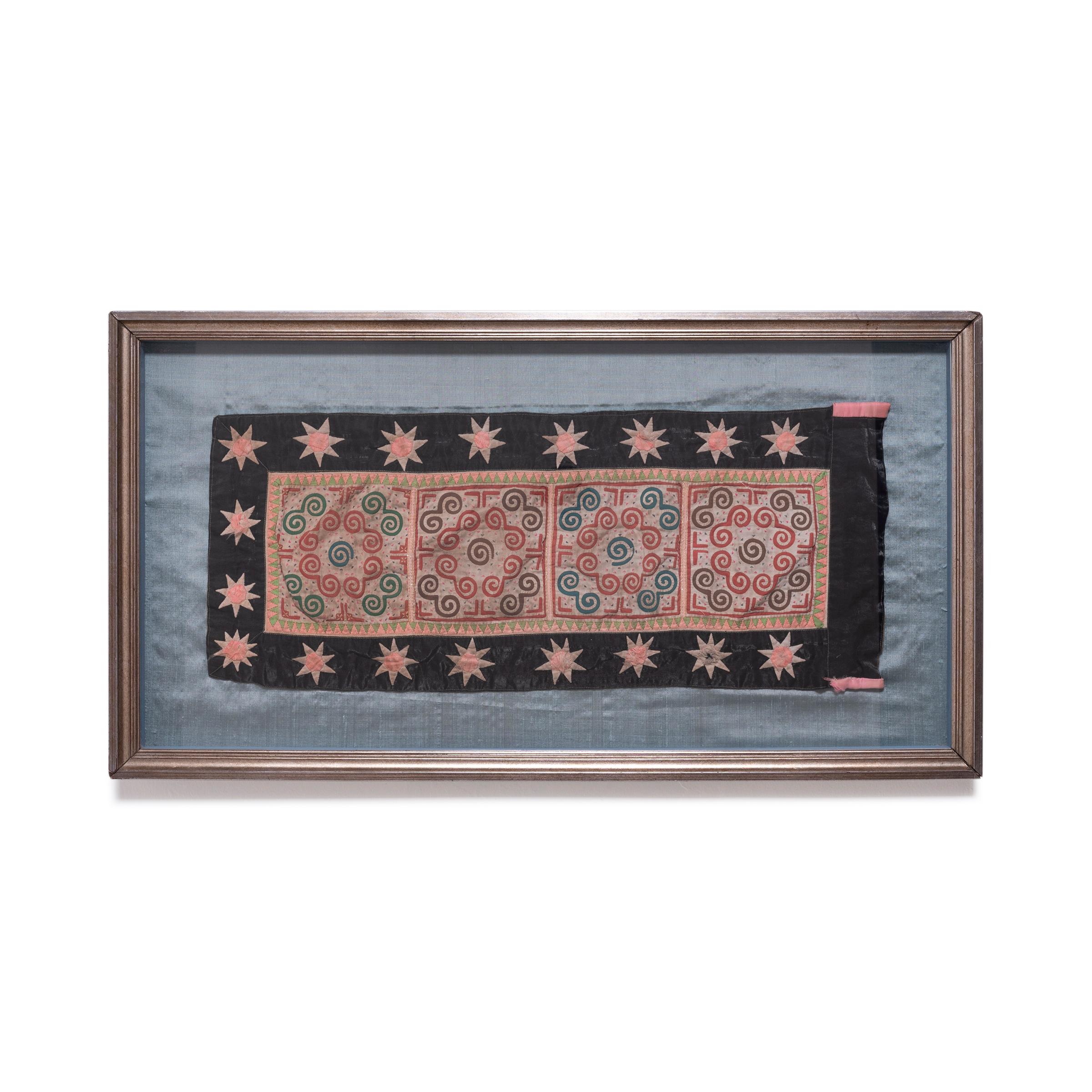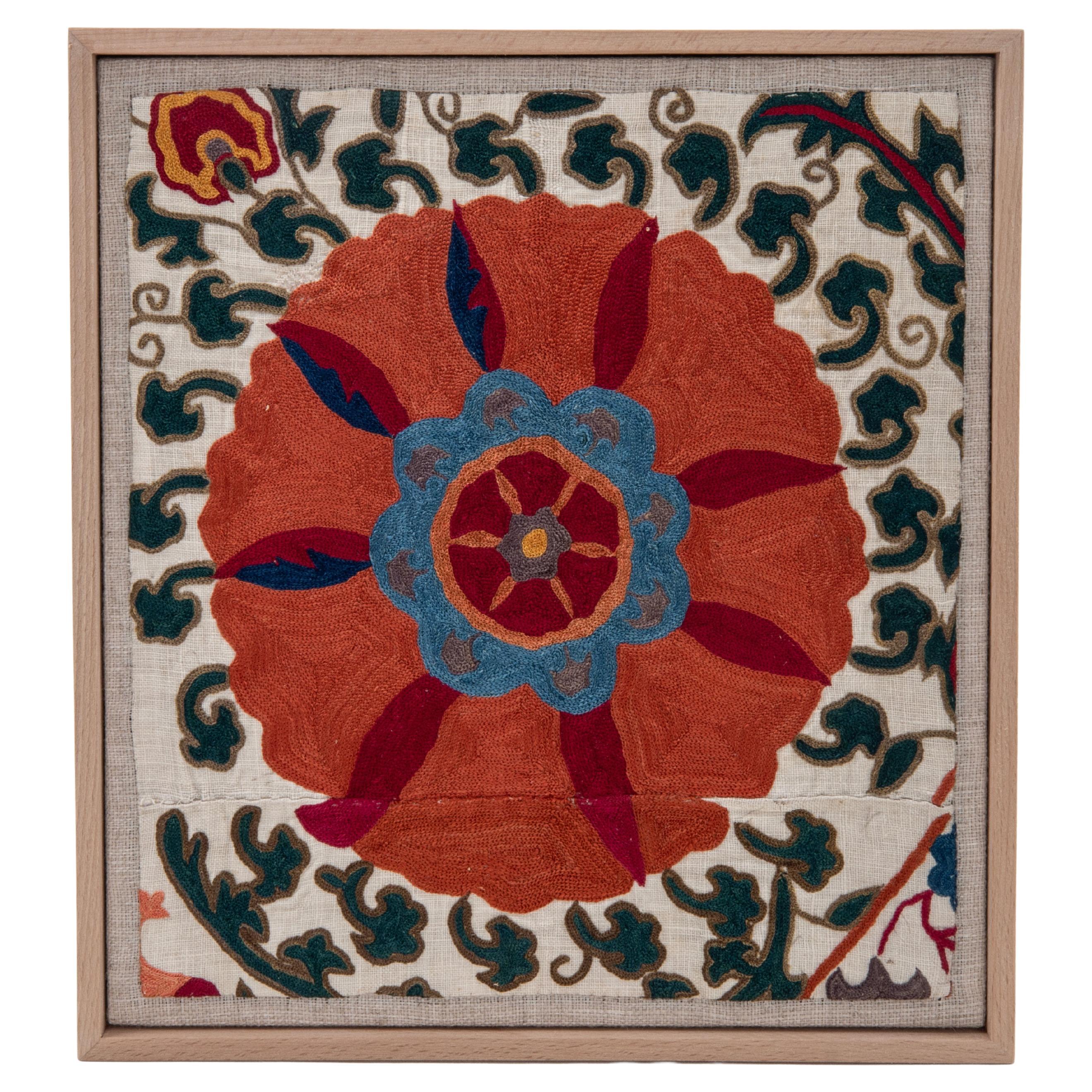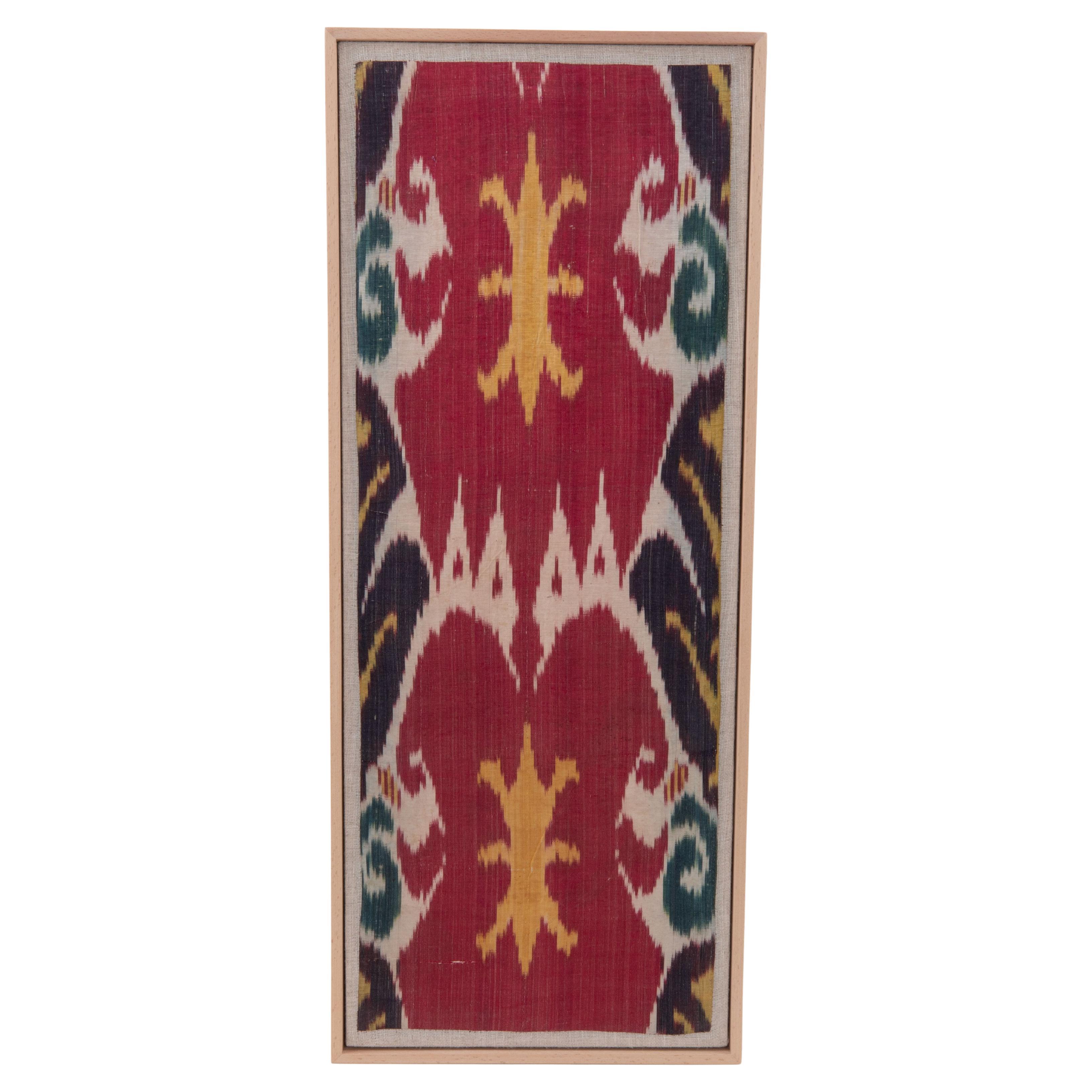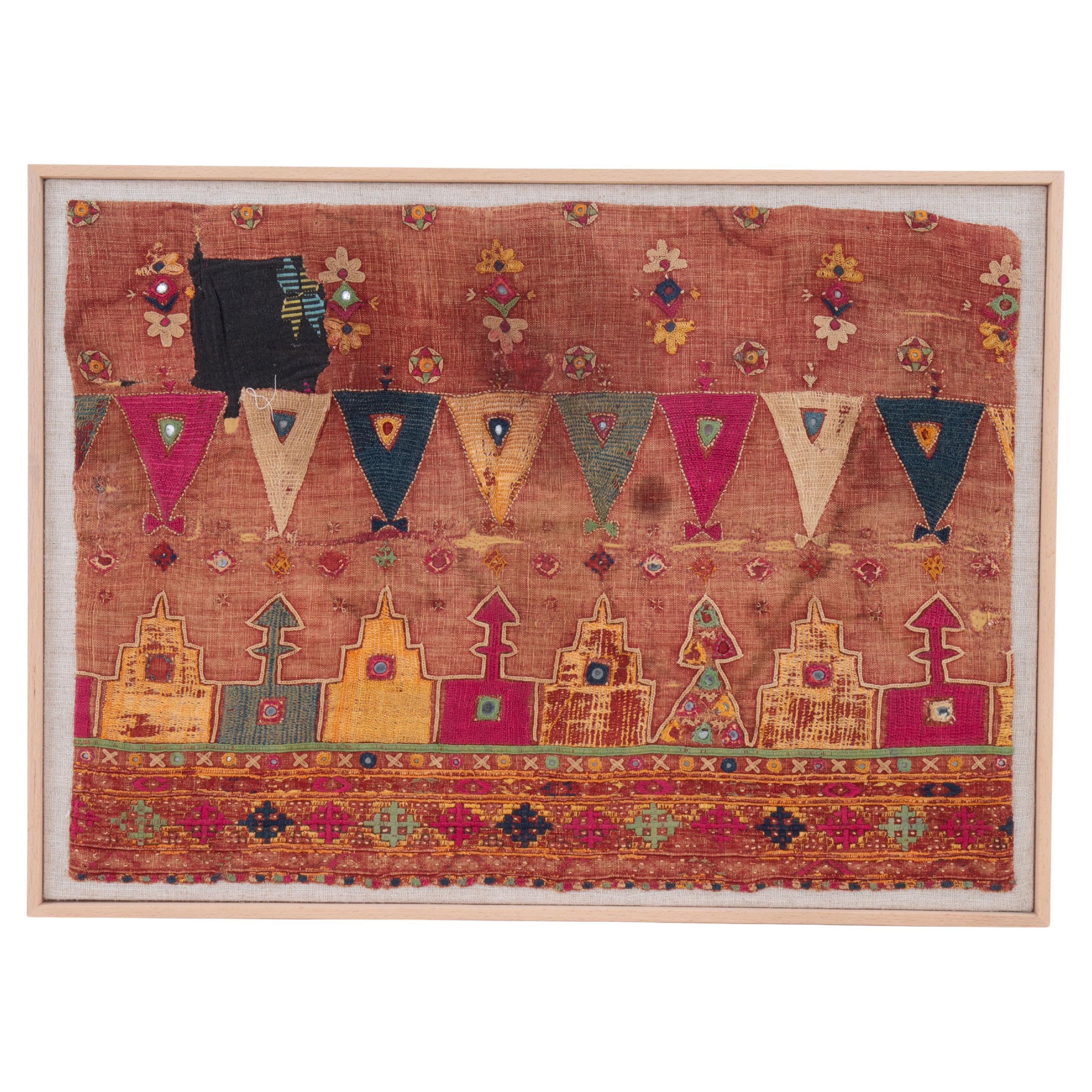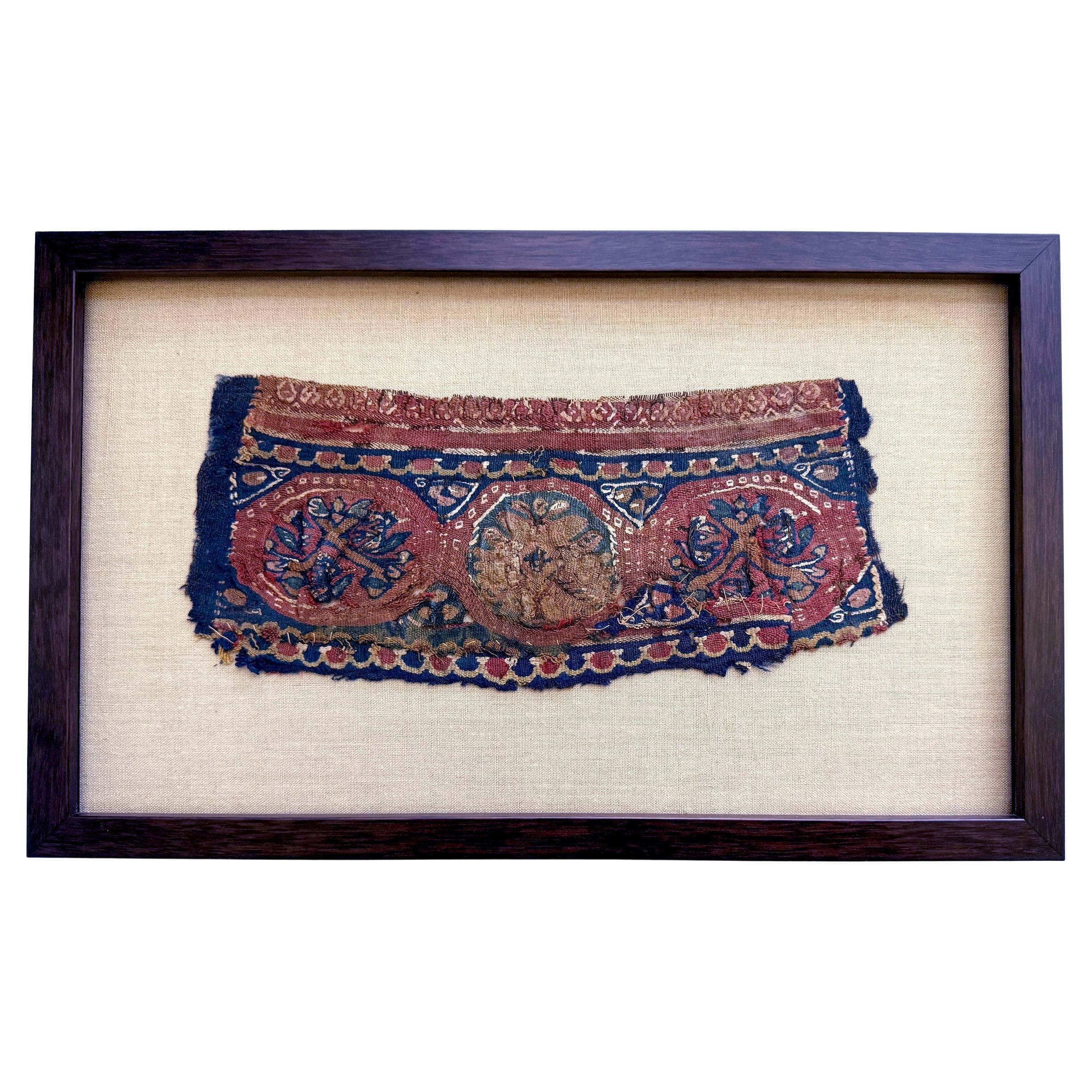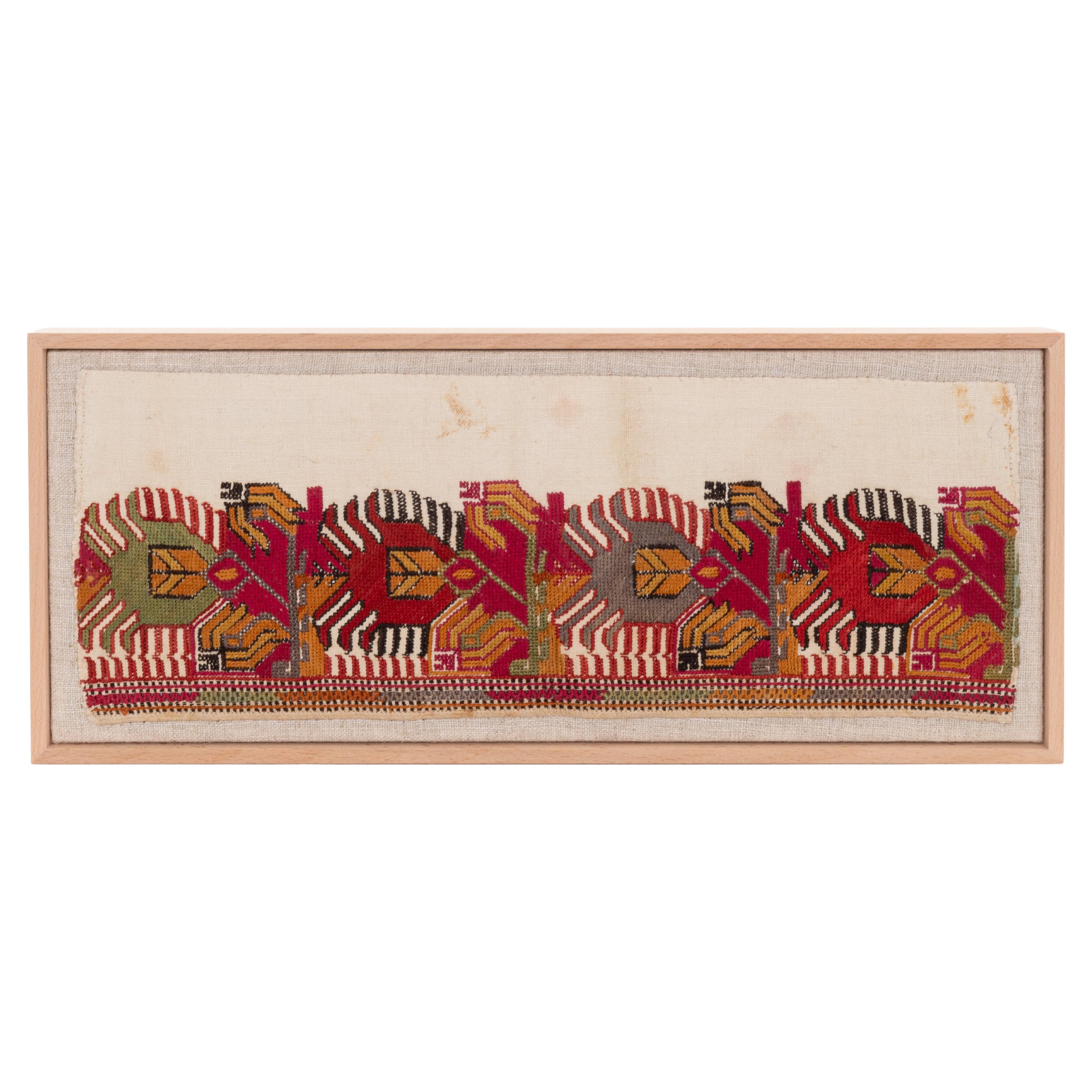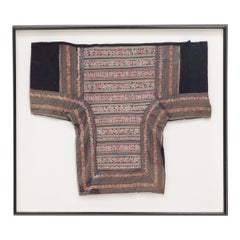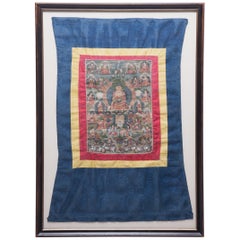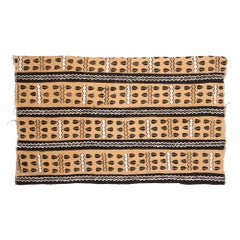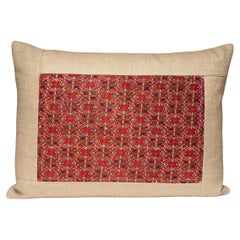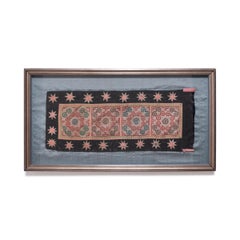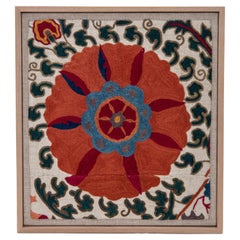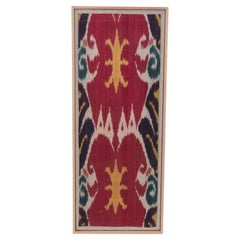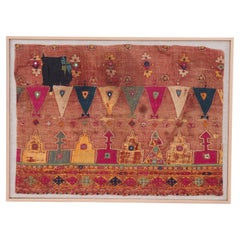Items Similar to Framed Hmong Appliqué Textile Fragment
Want more images or videos?
Request additional images or videos from the seller
1 of 5
Framed Hmong Appliqué Textile Fragment
$2,280
£1,747.06
€2,009.52
CA$3,259.57
A$3,540.49
CHF 1,874.39
MX$42,749.18
NOK 23,399.87
SEK 22,167.66
DKK 15,004.94
About the Item
Dating to the mid-20th century, this colorful Hmong textile is a classic example of the appliqué technique used for the traditional cloth known as paj ntaub. Appliqué is the process by which patches of fabric are sewn onto a different piece of fabric to form a new pattern.
Paj ntaub is an integral part of Hmong culture and fashion, in particular a source of great pride to Hmong women. The brightly colored embellishments, often on darker fabric, were a staple for clothing used in traditional celebrations including marriages, births, holidays and other important events. Through periods of persecution, Hmong women began preserving their language through imagery, stitching secret messages onto their clothes as they migrated from village to village. The paj ntaub quickly became a way to hold onto the identity and culture of the Hmong people, even going so far as evolving into story clothes depicting scenes, events, and narratives from their oral history.
This framed paj ntaub fragment is comprised of intricate appliqué patterns enclosed by a black border with white and pink stars (hnub qub). At the center of the textile are four squares with various ancient Hmong symbols. Each has a central coil (lub qwj yees) symbolizing family growth and interrelatedness. Surrounding the spiral are eight snails (qab qwj) which represent the union of two families and can also symbolize the spinning motion used in many spiritual chants. Lining each square is a step motif (theem ntaiv), which can be interpreted to represent the nomad lifestyle of the Hmong people. Lastly, there is a border with a repeating triangle pattern surrounding all four squares representing mountains (rooj), believed to embody strength. While some of the traditional meaning of paj ntaub imagery has been lost with various interpretations, the art remains alive, preserving connections with a lost homeland.
From the collection of Frances and Gary Comer.
- Dimensions:Height: 18.5 in (46.99 cm)Width: 34.5 in (87.63 cm)Depth: 1.5 in (3.81 cm)
- Style:Folk Art (In the Style Of)
- Materials and Techniques:Fabric,Appliqué
- Place of Origin:
- Period:
- Date of Manufacture:20th Century
- Condition:Wear consistent with age and use. Minor fading.
- Seller Location:Chicago, IL
- Reference Number:Seller: CFC2851stDibs: LU820035861842
About the Seller
5.0
Platinum Seller
Premium sellers with a 4.7+ rating and 24-hour response times
Established in 1997
1stDibs seller since 2006
1,727 sales on 1stDibs
Typical response time: 2 hours
- ShippingRetrieving quote...Shipping from: Chicago, IL
- Return Policy
Authenticity Guarantee
In the unlikely event there’s an issue with an item’s authenticity, contact us within 1 year for a full refund. DetailsMoney-Back Guarantee
If your item is not as described, is damaged in transit, or does not arrive, contact us within 7 days for a full refund. Details24-Hour Cancellation
You have a 24-hour grace period in which to reconsider your purchase, with no questions asked.Vetted Professional Sellers
Our world-class sellers must adhere to strict standards for service and quality, maintaining the integrity of our listings.Price-Match Guarantee
If you find that a seller listed the same item for a lower price elsewhere, we’ll match it.Trusted Global Delivery
Our best-in-class carrier network provides specialized shipping options worldwide, including custom delivery.More From This Seller
View AllEmbroidered Miao Baby Carrier Textile
Located in Chicago, IL
The connection between love and embroidery is nowhere stronger than among the minority peoples of China. Hand-stitched by a mother herself or gifted by the women in her family, the t...
Category
Early 20th Century Chinese Folk Art Textiles
Materials
Silk, Cotton
Tibetan Thangka of Sakyamuni with Silk Brocade, C. 1880
Located in Chicago, IL
Historically in Buddhist Tibet, patrons and monks commissioned thangka art, or sacred painting, to focus their meditations and prayers. This 19th-century Tibetan Thangka, painted in rich red, green, and blue pigments, still maintains incredible vibrancy. The central figure is the Sakyamuni Buddha, seated in the diamond position with alms bowl...
Category
Antique Late 19th Century Tibetan Tibetan Paintings and Screens
Materials
Linen, Silk
Bogolan Cowrie Shell Mud Cloth Textile
Located in Chicago, IL
Commonly known as Bogolan or Bògòlanfini, this cotton textile was hand spun, handwoven, then dyed through a technique that has been passed down in the Bamana region of Mali for centu...
Category
20th Century Malian Folk Art Pillows and Throws
Materials
Cotton
Central Asian Embroidery Throw Pillow
Located in Chicago, IL
This hand-crafted pillow was designed by a local Chicago artist and textile historian who lovingly repurposes vintage fabrics, garments and embroidery fragments collected during her ...
Category
21st Century and Contemporary American Folk Art Pillows and Throws
Materials
Linen
Chinese Quadrilobe Fabric Pillow with Embroidery
Located in Chicago, IL
This Chinese pillow was hand crafted by an artisan of the Republic Era (1912–1949). Constructed in the style of traditional ceramic or wood headrest, this pillow has an hour glass fo...
Category
Early 20th Century Chinese Qing Textiles
Materials
Cotton, Silk
Bogolan Cowrie Shell Mud Cloth Textile
Located in Chicago, IL
Commonly known as Bogolan or Bògòlanfini, this cotton textile was hand spun, handwoven, then dyed through a technique that has been passed down in the Bamana region of Mali for centu...
Category
20th Century Malian Folk Art Pillows and Throws
Materials
Cotton
You May Also Like
Framed Hmong Appliqué Textile Fragment
Located in Chicago, IL
Dating to the mid-20th century, this colorful Hmong textile is a classic example of the appliqué technique used for the traditional cloth known as paj n...
Category
Mid-20th Century Folk Art More Art
Materials
Textile
Framed Antique Uzbek Suzani Embroidery Fragment , 19th Century.
Located in Istanbul, TR
First the fragment has been hand backed on a linen fabric, then stretched over a wooden stretcher and finished with a wooden frame.
19th C. Uzbekistan
Ready to go on a wall.
Framed ...
Category
Antique Mid-19th Century Uzbek Suzani Decorative Art
Materials
Silk
Framed Antique Silk and Cotton Ikat Fragment, Uzbekistan
Located in Istanbul, TR
First the fragment has been hand backed on a linen fabric, then stretched over a wooden stretcher and finished with a wooden frame.
Late 19th C. Tajikstan
Ready to go on a wall.
Fra...
Category
Antique 19th Century Uzbek Folk Art Decorative Art
Materials
Silk
Framed Antique Gujarat Embroidered Skirt fragment, Erly 20th C.
Located in Istanbul, TR
First the fragment has been hand backed on a linen fabric, then stretched over a wooden stretcher and finished with a wooden frame.
Early 20th C. India
Ready to go on a wall.
Framed...
Category
Early 20th Century Indian Tribal Decorative Art
Materials
Silk
Framed Antique Coptic Textile Fragment from Byzantine North Africa
Located in Atlanta, GA
A small piece of antique Coptic textile woven as a horizontal band with two linear scallop borders flanking three central medallion design. Each medallion has a concentric pattern wi...
Category
Antique 15th Century and Earlier Egyptian Archaistic Shadow Boxes
Materials
Wood, Wool
Professionally Framed Greek Embroidered Chemise Hem Fragment, 19th C.
Located in Istanbul, TR
First the fragment has been hand backed on a linen fabric, then stretched over a wooden stretcher and finished with a wooden frame.
Late 19th C. Greece.
Ready to go on a wall.
Frame...
Category
Antique 19th Century Greek Folk Art Decorative Art
Materials
Silk
More Ways To Browse
Vintage Applique Patterns
1840 Sampler
Alexander The Great Tapestry
Antique Chinese Embroidered Tapestry
Antique Silk Embroidery Picture
Calder Tapestry Wall
Eila Ampula
Georgian Silk Embroidery
Green And Blue Tapestry
Licorne Antique
Marie Cuttoli
Mortlake Tapestry
Peacock Wall Hanging
Swan Tapestry
Tapestries Of Paris France
Tapestries With Horses
Tapestry Blue And White
Tapestry Dog
